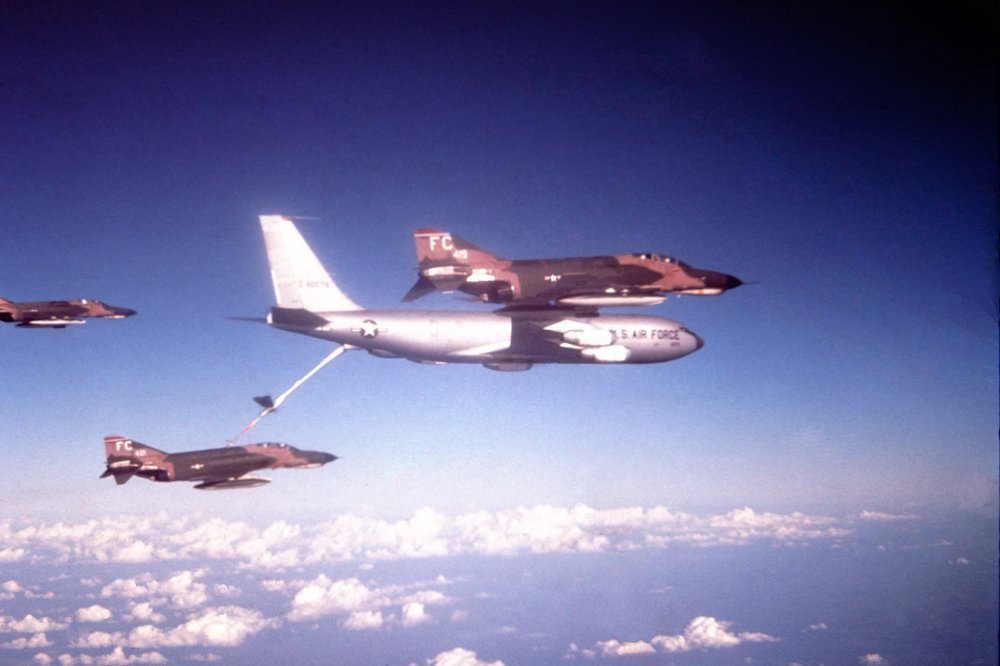The KC-135 Stratotanker North Star had its landing gear down and its engines at idling speed in an attempt to slow down enough to match the F-4 Phantom’s speed and perform a midair tow.
Ron Craft, a KC-135 Stratotanker crew member who was stationed at Loring Air Force Base (AFB) from 1981 to 1985, was only 23 years old when he got his first chance to travel off base on a trip escorting 24 F-4 Phantom II fighter jets across the Atlantic on Sep. 5, 1983.
The fighter jets didn’t have the capacity to fly long distances without refueling, so the trip to an Air Force base in Germany required six Boeing KC-135 tankers to escort them.
As Craft, the assistant crew chief on the KC-135 (callsign “North Star”) loaded with 70,000 pounds of fuel, explained to Bangor Daily News about midway across the Atlantic one of the fighter jets started having mechanical issues.
The crew made the decision to reroute the tanker and jet to make an emergency landing at the Gander International Airport in Newfoundland, Canada.
“We turned for Newfoundland because this was the closest piece of dirt to us,” Craft said. “We were hovering over 30-degree water with 60-foot swells. We could see the foam coming off the water at 1,600 feet in the air.”
As the fighter jet made its way toward its target, an oil leak forced an entire shutdown of one of the jet’s two engines. Capt. Robert E. Goodman, the tanker’s commander, told the crew to try to hook up the refueling boom to the fighter jet to help pull it along, according to the U.S. Air Force’s account of the incident.
At this point, because of the engine problems, the fighter jet was tilted at a 45-degree angle, Craft said, struggling to keep its altitude as it slowed down. The tanker slowed down to 230 mph — 50 percent slower than normal flight speed — to try to connect to the disabled aircraft.
The fighter pilot “had a little bit of lift, and he’s going so slow. A fighter can’t go that slow,” Craft said. “The slow speed put the jet in danger of losing the lift needed to stay airborne, which would have sent the plane plummeting into the Atlantic.”
Craft explained that by this point, the F-4 had lost all its hydraulics and couldn’t turn right. Craft recalls that the F-4 was flying at a virtual crawl, as it attempted the 500-mile journey toward an emergency landing in Newfoundland.
The refueling tanker that Craft was on had its landing gear down and its engines at idling speed in an attempt to slow down enough to match the jet’s speed and perform a midair tow.
“If the tow, which was actually a refueling boat used as a dive bar, didn’t hook on to the jet, the two pilots inside would have had about 90 seconds of consciousness after hitting such frigid Atlantic,” Craft said.
Despite all the challenges, the crew managed to safely assist the fighter to Gander.
Craft said he was so young and inexperienced at in-flight missions at the time that he thought this kind of activity was routine.
He later realized the magnitude of what had occurred: The flight crew saved the lives of two F-4 pilots, completing a rescue attempt that had never been practiced.
After the 1983 incident, the crew of the KC-135 received the Mackay Trophy, given by the U.S. Air Force for “the most meritorious flight of the year.”
More information about this story can be found on Ron Craft’s Hell Over High Water Facebook page.

Photo by U.S. Air Force

